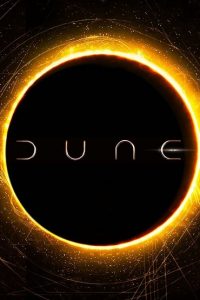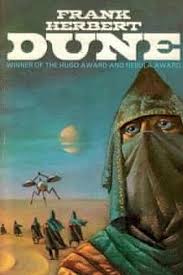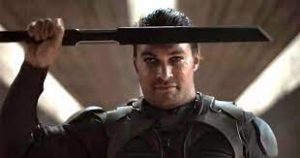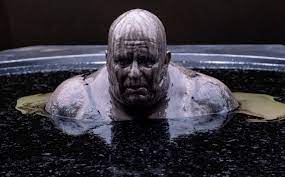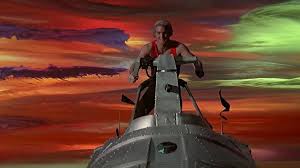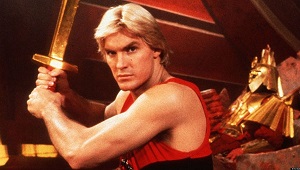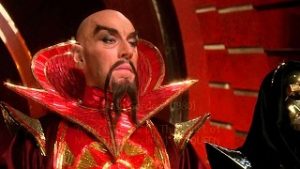
© Hoya Productions / Warner Bros. Pictures
William Friedkin’s most influential movie arrived two years after The French Connection. This was his horror masterpiece about a demonically-possessed child, The Exorcist (1973), which achieved two things the mainstream film industry had previously thought impossible. Firstly, it showed that horror movies could do big box-office business (something reinforced by Steven Spielberg’s Jaws two years later). Secondly, it proved that horror movies could be as hard-hitting and adult in tone as anything coming from the New Hollywood Generation, who shook up American filmmaking in the 1970s and included Francis Ford Coppola, Martin Scorsese, Peter Bogdanovich, Paul Schrader and John Milius. Mind you, the idea of serious horror movies had diminished again by the 1980s. That was when many horror filmmakers decided it was more fun to tell stories about horny teenagers being murdered in inventive ways by homicidal maniacs in hockey masks.
The Exorcist was released in cinemas around the time I first saw The Night They Raided Minsky’s on TV. My family was living in Northern Ireland then and I remember a young guy called Lawrence Timlin, who worked for my dad, telling me about how he’d seen The Exorcist twice. The first time was during his wanderings in London and the second time was after he’d returned home to Northern Ireland. The version he’d seen in a Northern Irish cinema, he said indignantly, had had many things cut out of it, no doubt from fear of what Northen Ireland’s sizeable communities of religious nutcases (both Catholic and Protestant) would say if they were left in. Mind you, that didn’t stop those nutcases picketing cinemas when the film opened in the province anyway.
A decade later, when I finally saw The Exorcist, it wasn’t in ideal circumstances. I was at college and staying in a hall of residence. The hall’s residents’ committee organised a showing of it one Sunday afternoon. As a result, I saw it in a common room with about 40 other people, all of us squinting at a TV set, on which it was playing from a VCR. Definitely not a big-screen experience. Still, I was lucky that I saw it at all. For, in a decision that highlights yet again the cultural idiocy of Maggie-Thatcher-era Britain, video sales of The Exorcist were banned by the British Board of Film Classification in 1988. They were afraid of the effect it might have on ‘young people’ who saw it at home: “At the cinema it had been relatively easy to ensure that young people would be excluded, but video was another matter.” Home video sales of The Exorcist remained illegal in the UK until 1999. At least in 1998 I managed to catch it in a cinema, on a big screen at last, during a special release marking its 25th anniversary.
I have misgivings about The Exorcist’s philosophy. I find facile its depiction of evil as an opportunistic, external force – when the idea that evil is something internal, that potentially resides inside every human being and can be activated by the right combination of circumstances (especially weakness of character), is more disturbing. Even more facile is the idea that the Catholic Church is the line of defence holding evil at bay. That seems laughable today, given that in the half-century since 1973 it’s become clear that the church’s cassocked ranks have harboured far more threats to young people than video sales of The Exorcist could ever have posed.
But those are issues I’d blame on the movie’s script and source novel by William Peter Blatty. Its performances and Friedkin’s direction can’t be faulted. He handles the famous set-pieces – rotating heads, projectile vomiting, the manifestation of the demon Pazuzu to Father Merrin (Max von Sydow) in Iraq – with aplomb. And von Sydow’s arrival at the residence of Chris MacNeil (Ellen Burstyn) and possessed daughter Reagan (Linda Blair), when he stands silhouetted in mist, his outline delineated by a glowing streetlamp mixed with a shaft of light from an upstairs bedroom-window, is absolutely magical – perhaps the most seminal image of the horror genre. The insertion of music from Mike Oldfield’s classic prog-rock album Tubular Bells (1973) during an early scene works brilliantly too. And I say that as someone who normally hates progressive rock.

© Hoya Productions / Warner Bros. Pictures
Seven years later, Friedkin generated more controversy with his 1980 thriller Cruising. This has Al Pacino playing a New York cop who goes undercover in the city’s gay S&M scene, in order to track down a serial killer who’s murdering gay men. I didn’t see Cruising until the 1990s and I watched it at the insistence of an ex-girlfriend who was enthralled by the film. Maybe she got turned on by seeing Al Pacino in a tableau of gay sex and S&M. The film was condemned by New York’s gay community, who felt that by focusing on the city’s ‘leather bars’ it was linking all gay culture with violent sex. In the film’s defence, Pacino claimed that it concentrated only on one sub-culture and could no more be accused of slandering the whole gay community than a film that dealt with the Mafia could be accused of slandering the whole Italian-American community. Maybe so, but in 1980 mainstream America was a lot more aware of and at ease with its Italian-American component than it was with its gay component. It might be able to distinguish between the specific and general in the former community, but could it do so in the latter?
Whatever – despite the issues about what it portrayed and how it portrayed it, I think Cruising is a pretty good thriller. Though I obviously didn’t get the kick out of it that my ex-girlfriend did.
It was also in the 1990s that I saw a Friedkin movie that made me wonder if, creatively, he’d fired his last bolt. This was the 1990 horror movie The Guardian, which has Jenny Seagrove playing an angelic English nanny who’s actually a dryad. She abducts the children entrusted to her care and sacrifices them to the gnarly old tree that she’s an extension of. Seagrove had form playing mythological creatures, having turned up in Bill Forsyth’s Local Hero (1983) as a mermaid who bewitches Peter Capaldi.
Horror movies about trees are generally not good – see From Hell It Came (1957), The Woman Eater (1958), Maneater of Hydra (1967) or the anthology movie Tales That Witness Madness (1973), which has an episode where Joan Collins is spurned by her husband because he’s become obsessed with a weirdly human-female-shaped tree trunk he’s found out in the woods. (No jokes please about the tree trunk being a better actress.) The Guardian unfortunately doesn’t buck the trend. About the nicest comment about it was made by Time Out magazine, which chortlingly described it as: “A severely flawed but not unamusing venture from a director who should know better.” The film was co-scripted by the estimable Welsh writer Stephen Volk. It was Volk, apparently, who got Friedkin hooked on the tree angle – the film’s source novel, Dan Greenburg’s The Nanny (1987), has no such material in it. However, once Volk had shown Friedkin the 1904 short story The Ash-Tree by M.R. James, the director was adamant. His movie had to have a killer tree!

© Universal Pictures
But happily, Friedkin enjoyed a renaissance in the early 21st century. This was largely thanks to an association with the playwright Tracy Letts. First came the claustrophobic and entomophobic Bug (2006), based on Letts’ 1996 play of the same name and starring Ashley Judd and Michael Shannon. Many people reacted to Bug by hailing it as an accomplished horror movie, which caused Friedkin to grumpily complain that it was no such thing. For him it was ‘a black comedy love story.’ Well, I consider Bug to be both a pretty smart horror movie and an unsettling character study, with its two lead actors playing the messed-up protagonists with wonderful intensity.
Then in 2011 we got Killer Joe, an adaptation of Letts’ 1993 play, again of the same name. This is about a family of Texan trailer trash hiring the titular hitman (Matthew McConaughey) to rub out their estranged wife / mother so they can get their hands on her life insurance policy. A flamboyantly unhinged character, Joe agrees to the job, but only if he gets custody of the family’s youngest daughter, the simple-minded Dottie (Juno Temple), as a down-payment for it. An unhealthy relationship soon develops between Dottie and the forty-something Joe. “How are you gonna kill my mama?” she asks him at one point. “That’s not appropriate dinner conversation, Dottie,” he chides her.
From there, things become even darker and there’s a simultaneously horrific and hilarious finale that involves the family’s devious stepmother (Gina Gershon) being forced to do some unspeakable stuff with a chicken drumstick. Killer Joe is an excellent slice of ‘Southern Gothic’ and benefits hugely from a barnstorming central performance by McConaughy. When he warns, “If you insult me again, I will cut off your face and wear it over my own – do you understand?”, you believe him.
There are still Friedkin movies I haven’t seen but would like to. I hear that 1985’s To Live and Die in L.A. with William Petersen and Willem Dafoe is very good, and I’d also like to catch up with his 1968 film version of Harold Pinter’s play The Birthday Party with Robert Shaw, Dandy Nichols and Patrick Magee. The latter film was produced by Max J. Rosenberg and Milton Subotsky, whose company Amicus Productions was better known for making horror films. I doubt if it’s a coincidence that images from Rosenberg and Subotsky’s first-ever horror venture, 1960’s City of the Dead, appear on a television screen during a scene in Killer Joe.
So… William Friedkin was a filmmaker who brought us harrowing tales of serial killers, deranged hitmen and psychotic cops. He raced cars against elevated trains and coaxed explosives-laden trucks across flimsy rope bridges. He consorted with monstrous woodland entities, with the devil, and with Norman Wisdom. He even managed to make progressive rock sound cool – twice. Truly a man of many achievements.

© Voltage Pictures / LD Entertainment

